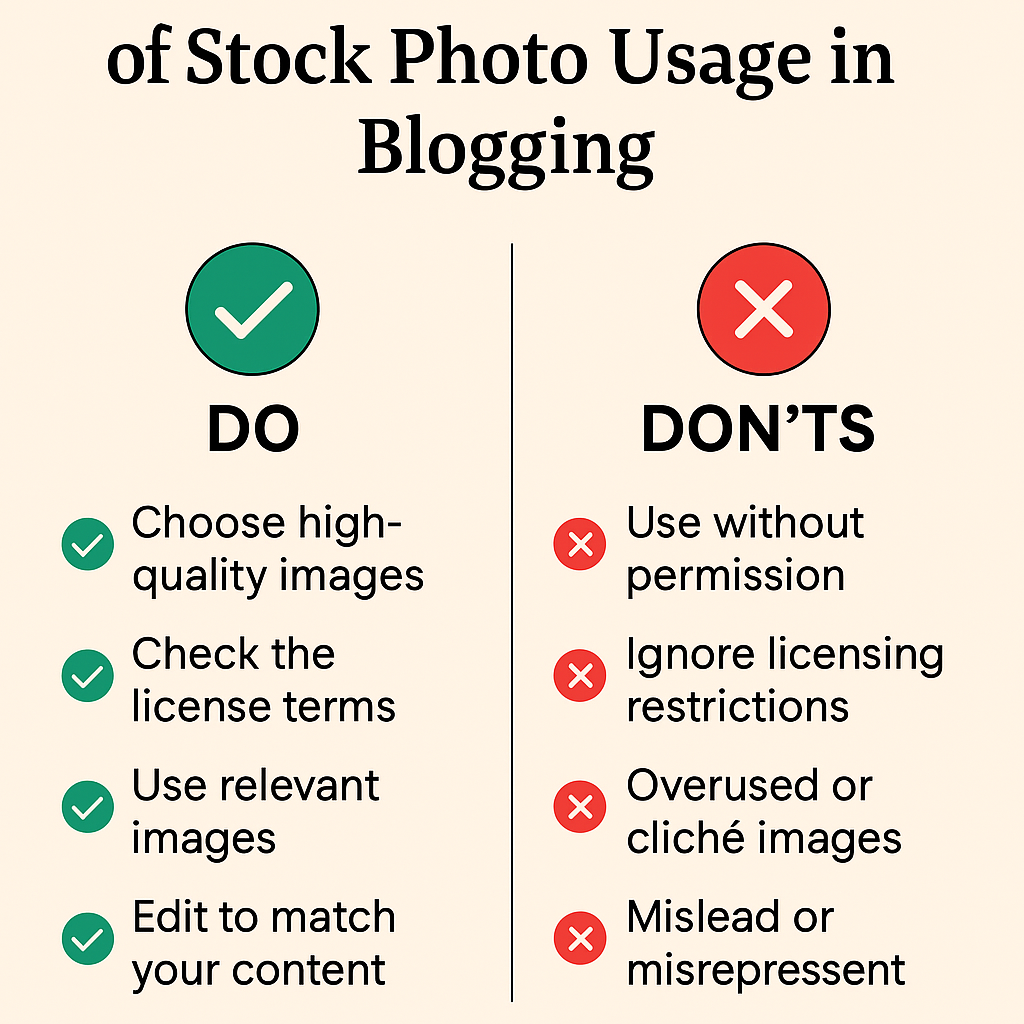The Do’s and Don’ts of Stock Photo Usage in Blogging
Visuals matter more than ever. Blog posts with images consistently outperform those without—they grab attention, improve readability, increase shares on social media, and even boost SEO. For many bloggers, stock photos are an essential go-to for quickly and affordably sourcing visuals. But using them comes with a set of rules, both legal and creative, that are often overlooked.
Whether you’re a seasoned blogger or just starting out, understanding the right way to use stock photos can save you from copyright issues and help elevate your content to a more professional level. Here are the key do’s and don’ts every blogger should know when working with stock imagery.
Do: Understand Licensing Terms
One of the most critical steps when using stock photos is understanding the licensing agreement attached to the image. Not all stock photos are created equal. Some are free for commercial use without attribution; others may require crediting the photographer or can only be used for editorial purposes.
Licenses generally fall into a few categories:
- Royalty-Free: You pay once (or not at all, if free), and you can use the image multiple times, often with few restrictions.
- Rights-Managed: You pay based on how, where, and for how long the image will be used.
- Creative Commons: A wide range of licenses, from full freedom with no attribution to strict requirements including no modification or commercial use.
Always read the fine print. Misusing an image—even unintentionally—can lead to legal action, takedown notices, or financial penalties.
Don’t: Assume an Image Is Free Just Because It’s Online
This is one of the most common and dangerous mistakes bloggers make. Just because an image shows up on a Google search or someone else’s blog doesn’t mean it’s fair game. Every photo has a creator, and in most cases, that creator holds the copyright.
Using copyrighted content without permission can result in serious legal consequences, even if you link back to the original source or include a disclaimer. It’s better to stick with properly licensed stock photos or create your own visuals.
Do: Choose Authentic, High-Quality Images
A blog’s credibility is often judged, at least in part, by its visuals. When selecting stock photos, aim for authenticity and quality. Images should feel natural, not overly posed or clichéd. Look for real emotions, candid moments, and diverse representation that reflects your audience.
Stock photo libraries have improved dramatically in recent years, offering more inclusive and less “stocky” images than in the past. Take the time to dig deeper than the first page of results. Original, less-used images help your blog stand out and feel more genuine.
Don’t: Use Overused or Cliché Stock Photos
We’ve all seen them—the smiling handshake, the exaggerated office celebration, the perfectly staged salad. These kinds of images scream “stock photo” and can make your blog feel generic or insincere.
Using widely circulated stock images can also hurt your brand identity, especially if your readers see the same image used across multiple unrelated sites. This dilutes your message and makes your content feel less unique.
Avoid clichés by searching with more specific keywords and filtering results by popularity or recency. Better yet, personalize your visuals by combining stock photos with your own graphics or brand elements.
Do: Edit and Customize Where Appropriate
One of the benefits of royalty-free stock photos is that they often come with the freedom to edit and modify. Customizing stock images can help integrate them more seamlessly into your blog’s design. Consider:
- Adding your brand colors, text, or logos.
- Cropping to highlight a specific element.
- Adjusting lighting, filters, or orientation for consistency.
These small tweaks can make a big difference in making the image feel like part of your blog, rather than something tacked on.
Just be sure that your license allows for edits—and never alter the image in a way that could be considered defamatory or misleading, especially if people are depicted.
Don’t: Forget About Attribution When Required
Even with royalty-free or free-to-use images, some licenses require attribution. This means crediting the photographer or source in a specific format, often including a link back to the original image.
Failing to provide attribution when it’s required is a breach of the license and could get you into trouble. Attribution doesn’t just protect you legally—it’s also a good practice to recognize the work of creators.
To stay safe, always keep track of where each photo came from and the license terms. If you’re unsure, err on the side of giving credit or find a more clearly licensed alternative.
Do: Maintain a Consistent Visual Style
Consistency is key when it comes to building a strong brand identity. While stock photos are often sourced from many different contributors, you can still maintain visual harmony across your blog.
Consider creating a style guide for your images. Think about:
- Color palette
- Lighting style (bright vs. moody)
- Subject matter
- Composition and framing
- Use of filters or overlays
Using editing tools to standardize these elements across your images can create a cohesive look that reinforces your blog’s tone and message.
Don’t: Use Stock Photos for Sensitive Topics Without Caution
If your blog deals with serious or sensitive topics—like mental health, politics, diversity, or personal identity—be especially careful with stock images. A poorly chosen photo can feel disrespectful or tone-deaf, even if it’s technically legal to use.
Avoid stereotypes, staged dramatizations, or overly simplified imagery that could diminish the subject matter. Instead, opt for photos that reflect real people and real situations whenever possible. If appropriate, consider creating your own imagery or working with contributors who understand the topic deeply.
Do: Optimize for Performance and SEO
Beyond aesthetics and legality, stock photos should also serve a functional role in your blog. Make sure you:
- Compress images to reduce load times.
- Add descriptive ALT text for accessibility and SEO.
- Name your image files with relevant keywords.
- Use responsive sizes for mobile-friendliness.
These small but essential steps ensure that your stock images don’t just look good—they also contribute to your blog’s performance and visibility.
Don’t: Let Stock Images Replace Original Content
While stock photos are useful, they should never replace your original voice, ideas, or identity. Use them to support your content, not to define it. When possible, incorporate your own visuals—like behind-the-scenes shots, screenshots, infographics, or custom illustrations.
Even if you’re not a professional photographer, today’s smartphones and editing apps make it easier than ever to create your own images. Combining original and stock content is a great way to balance efficiency with authenticity.
Conclusion
Stock photography is a powerful resource for bloggers, but it comes with its own set of responsibilities. By using images thoughtfully and ethically, you can enhance your blog’s visual appeal, avoid legal pitfalls, and build a more trustworthy brand.
The key takeaways? Always read licenses. Avoid lazy clichés. Customize when possible. And above all, use stock photography as a tool—not a crutch. When used well, the right images can transform your blog from ordinary to extraordinary.




